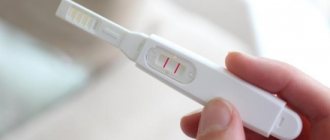SPECIALISTS Gynecologist Gynecologist-endocrinologist Pediatric gynecologist Mammologist-oncologist Dermatologist Hirudotherapist Intimate surgeon Contour plastic doctor Ultrasound doctor SERVICES AND PRICES Gynecology Mammology Ultrasound diagnostics Paid tests Intimate surgery Contour plastic Treatment for women PROMOTIONS AND DISCOUNTS Students Teams Friends and subscribers Residents m district For pensioners Promotions at the clinic
How many days later can pregnancy be determined if a girl has had sexual intercourse and no contraception was used? Or is this a long-awaited, planned event expected for a long time? In this material we will tell you about the main methods, how to quickly and more reliably find out about pregnancy and when it is best to use them.
So, the main thing is why is all this necessary and when should you take this issue to the clinic? Determining pregnancy in the early stages is necessary if at some point the girl felt the birth of a new life within herself. Either to one degree or another does not exclude such a possibility. I would like to say right away that we will not discuss the exact determination of weeks of conception and testing using “folk”, “grandmother’s” methods (soda, iodine) in order to save time. We will ignore various online services, such as “drop a drop of urine on the touchpad, move your finger counterclockwise and immediately find out the result in 1 minute”, for they are, at a minimum, not scientific, and more specifically, for quackery.
What signs will help identify pregnancy?
When a woman’s belly grows, the fetus begins to move noticeably, and there is no doubt about her position. But all this becomes obvious later. There are several determining factors with the help of which pregnancy is diagnosed at the first stage ; early signs of pregnancy are divided into several groups:
- Presumable. They are such because their appearance can be caused by other circumstances.
- Probable. These are clearer criteria that track the physiological changes that have occurred in the female body. The doctor knows how to diagnose pregnancy in the early stages using them.
- Reliable. They are recorded when parts of the embryo, the work of its heart and movement are detected.
Early signs of pregnancy
What symptoms can you suspect pregnancy? The body itself sends signals from which the necessary conclusions can be drawn. Women with maternal experience in the early stages may feel these changes and assume that a new addition to their family awaits them. If the child is the first, it turns out to be much more difficult to understand what is happening. Obstetric science, based on the timing of appearance in girls, identifies several groups of pregnancy symptoms (doubtful, probable and reliable). Let's look at each of them.
Doubtful (unlikely) signs:
- Changes in eating behavior.
- Perverted taste preferences.
- Violation of olfactory sensations.
- Variability of the nervous system.
- Weakness, malaise, drowsiness.
- Increased vaginal discharge.
- Frequent urination.
- Spotting of blood on the days of expected menstruation.
- Pain in the lower abdomen and vagina.
- Skin pigmentation (face, nipples, genitals, linea alba).
- Increased or decreased libido.
- Changes in appearance (breast enlargement, swelling, etc.).
- A woman's premonition (intuition).
Probable (acceptable) signs:
- Stopping menstruation.
- The appearance of colostrum from the nipples.
- Changes in the size, shape and consistency of the uterus.
- Cyanosis of the mucous membrane of the cervix and vagina, external genitalia.
Reliable symptoms:
- Ultrasound detection of the fertilized egg in the uterus.
- Visualization of the contraction of the heart of the embryo (fetus) with ultrasound.
What pregnancy looks like before menstruation
Early diagnosis of pregnancy before delay is based on presumptive symptoms:
- morning sickness, food aversion;
- acute negative reaction to odors;
- an increase in the volume of vaginal mucus;
- feeling of fullness in the area of the uterus;
- increased pain in the chest lobules;
- frequent urge to go to the toilet “in a small way”.
A woman can find out more precisely about the change in her position even before visiting a doctor by measuring basal temperature (BT). During pregnancy it will be more than 37 degrees. But you can trust this indicator if it was controlled during the previous cycle, and there is confidence that there is no inflammation in the reproductive system. Some women have a normal BBT above 37 even outside of conception.
Changes in basal temperature before pregnancy and after conception
At the doctor
Early diagnosis of pregnancy is based on interviewing the woman and examination by a gynecologist. At the first visit, the doctor will find out about her well-being, identifying possible symptoms of the condition. An inspection will provide more information. This method is implemented in two ways: using a two-handed examination and with a gynecological speculum.
A bimanual examination will allow you to determine:
- Compliance of the isthmus of the uterus.
- A change in the feel of an organ when, upon palpation, its muscles become denser and contract, and immediately afterwards relax.
- Growth in the size of the uterus at 5 weeks. From now on, it grows to the circumference of the egg and, instead of the shape of a pear, takes on the shape of a ball. The longer the period, the more it increases in size.
- Asymmetry of the uterus. The reason for this is the fertilized egg, which is attached to the side, creating a bulge in this place.
- Anterior tilt of the uterus and elasticity of the cervix.
In this part, the diagnosis of early and late pregnancy differs significantly.
In the second case, examination of the uterus will make it possible to detect parts of the embryo, heart sounds, movements of the unborn baby and its position. The organ itself will increase so much that it will be located at the lower border of the sternum. The diagnosis of early pregnancy can be determined based on probable symptoms. Upon examination, they will also be accompanied by a change in the pink color of the covering of the genital organs to bluish and swelling of the vagina.
Palpation of the mammary glands also includes diagnosis of early pregnancy: obstetrics records their swelling, increase in size, darkening of the nipples and the skin around them.
At what stage can pregnancy be determined?
To answer this question, it is necessary to consider the main features of physiological processes at short gestation periods. Immediately after sexual intercourse, sperm rush to the mature egg and fertilize it. The fertilized egg rushes into the fallopian tube. Progressing slowly, it reaches the uterus after a few days. According to the observations of embryologists, implantation of the fertilized egg occurs only on the 7–10th day after fertilization. This is the time that experts call when answering women’s questions about how many days it will take to find out about pregnancy.
The body begins to synthesize human chorionic gonadotropin (hCG). Its presence in biological fluids of the body helps to detect gestation at short notice. Using existing methods, the concentration of this hormone can determine the fact of pregnancy after 10–14 days from the moment of sexual intercourse. It is impossible to reliably determine the gestational age by establishing the concentration of hCG, so doctors use ultrasound.
Laboratory methods
Modern methods for diagnosing early pregnancy certainly include laboratory tests. They are based on the appearance of special manifestations of the presence of an embryo in a woman’s biological fluids. First of all, it is hCG. It is secreted by the membrane of the embryo and is detected in blood and urine tests. It can be detected by the earliest diagnosis of pregnancy before delay. It is not only the presence of hCG that is important, but also its significance at each level of fetal development. It reaches its highest level at 10-11 weeks, then gradually decreases. This property of the hormone allows one to observe and evaluate the situation in development.
It is advisable to diagnose pregnancy in very early stages, even 5 days before the delay.
Blood for diagnostics is donated from a vein. The main condition is that you should not eat for at least 4-6 hours before the test. It is imperative to warn specialists about taking medications containing hormones.
The presence of hCG in the urine provides the expectant mother with a chance to diagnose early pregnancy on her own. To do this, a test purchased at a pharmacy is placed in a glass of urine to the specified level. If there is pregnancy, it will be indicated by two stripes or a “plus”. But still, this method has a fairly high error rate.
Methods for determining pregnancy in the early stages:
- basal method
This is a fairly old way of determining pregnancy, which continues to be relevant to this day. As a rule, it is suitable for girls who have been planning for a long time or have been trying to get pregnant for a long time, because it requires monitoring for several months.
The method is based on measuring basal body temperature - one that does not depend on external factors. With the help of such manipulation, you can not only establish the fact of pregnancy, but also determine the most favorable period for conception, monitor the state of hormonal levels and even detect “female” diseases.
The measurement is quite simple: in the morning, as soon as the woman wakes up, she measures the temperature orally, vaginally or rectally. Depending on the values obtained, the woman can confirm or refute the assumption of pregnancy.
Throughout the entire cycle, the basal temperature changes: during the period of egg formation, the values are low - from 36.1 to 36.8, and immediately after ovulation, when the egg leaves the follicle, the values increase sharply to 37-37.7 degrees. This is due to the activity of hormones.
If pregnancy has occurred, the basal temperature continues to remain above 37 degrees until the placenta is fully formed. If the egg does not meet the sperm, it declines.
Why is it important to measure basal temperature in different phases of the cycle for 3-4 months? Because sometimes the increase is not associated with hormonal changes, but with pathological processes or individual characteristics of the female body.
- pregnancy test
Perhaps the most common and accessible, but not the most reliable way to determine pregnancy. The tests are sold in any pharmacy and even some supermarkets, they are inexpensive, and how to use them is written right on the packaging. The measurement takes only a few seconds and the result is ready almost immediately, but is it always worth trusting?
Of course not. Manufacturers are fighting for a pedestal in the market, so you can often find the phrases “result 24 hours after intercourse”, “99% reliability” and so on on packages. Of course, this is nothing more than a marketing ploy, and you cannot completely rely on the test results. In addition, it is better to purchase several tests from different manufacturers and price categories at once to get a more clear picture. But even in this case an error may occur.
There are other factors that affect the reliability of the result. These include:
- Expired test date;
- Improper conduct of the test;
- Using non-morning urine.
The test should be carried out no earlier than on the first day of the delay, immediately after waking up. If you postpone this moment until the evening, the liquid that the potential mother drinks will reduce the concentration of hCG in the urine, which will distort the results.
If several tests 2-3 weeks after ovulation show two stripes, it is better to additionally conduct another study, for example, take a blood test.
- visit to the gynecologist
A gynecologist can confirm pregnancy with a visual examination at 3-4 weeks of pregnancy. At this time, the color saturation of the vagina and cervix changes, the walls of the uterine cavity soften, the uterus enlarges, the labia swell, become cool and even change color. The density of the uterus, which the gynecologist assesses by palpation, increases.
This method is one of the most controversial. Firstly, many believe that such active intervention can provoke embryo rejection. Secondly, the method is not highly reliable. Thirdly, such noticeable changes in a woman’s genital organs usually occur no earlier than 7-10 weeks of pregnancy.
At the appointment, the gynecologist can immediately after the interview send the woman for a blood test or ultrasound - safer and more reliable methods for determining pregnancy.
- blood analysis
One of the most accurate, reliable methods that allows you to determine the fact of pregnancy already on the 8th day after conception. The essence of the analysis is to detect hCG, which, by the way, is much easier to detect in blood than in urine. The probability of error is extremely low.
- traditional methods
Many years ago, when medicine was not yet so developed, and there was no thought about creating a rapid test, women came up with and tested their own ways to determine pregnancy. Of course, they do not guarantee a 100% result, but just for fun, you can conduct simple experiments at home.
- Pregnancy detection using baking soda. Add baking soda to the container with urine and monitor the reaction: if an active reaction occurs with hissing and bubbling, the woman is not pregnant. If the soda settles in the form of a white precipitate, you can congratulate the future parents.
- Experiment with iodine. To do this, you need, as in the previous version, to drop a small amount of the reagent into the urine. If the iodine dissolves, conception will not occur. When pregnancy occurs, the drop will remain on the surface;
- Feeling the pulse of the abdomen. With the onset of pregnancy, a woman’s body changes greatly, the volume of the uterus and blood flow to it increase. It is believed that if you place your hand two fingers below the navel, a pregnant woman will be able to hear a rapid pulse.
More on the topic
Can ovulation occur during pregnancy?
Late ovulation and pregnancy: when will the test show the result?
Can there be toxicosis during a frozen pregnancy?
Is it possible to get pregnant a month after giving birth?
Why might black stool appear during pregnancy and is it worth worrying about?
Diagnostic capabilities of ultrasound
Ultrasound diagnostics of early pregnancy allows you to see an image of a moving fetus on the screen. From this, already from the 4th week the specialist will determine:
- location of the fertilized egg;
- the absence of such an anomaly as hydatidiform mole;
- duration of pregnancy;
- number of embryos;
- defects in fetal formation;
- probable problems with pregnancy;
- volume of amniotic fluid.
The earliest diagnosis of pregnancy using ultrasound is carried out precisely at the mentioned time, if there are negative prerequisites for the normal development of the process. Usually it is prescribed at 9-11 weeks.
Ultrasound is performed in 2 options:
- Transabdominal. It requires a full bladder so that the uterus rises and is better visible in all details. The pregnant woman's belly is covered with a special gel, which ensures the sliding of the sensor and the accuracy of the information received. The device is moved along the abdomen in such a way that there are two options for depicting the embryo: along and across. When manipulating, be sure to also capture endometrial tissue;
- Transvaginal diagnosis of early pregnancy. The sensor is inserted into the vagina, after putting a condom on it and lubricating the protection with gel. The patient is placed on a couch for the duration of the study, and the bladder must be emptied. Transvaginal ultrasound makes it possible to know about the characteristics of the embryo’s heartbeat already from the 6th week, as well as about its size, cell and tissue abnormalities.
The use of ultrasound made it possible to create such a research method as Doppler sonography. It is used to identify problems with blood flow in the arteries of the uterus. It is real and valuable thanks to obtaining a color image of what is happening. Such a diagnosis in case of a not entirely successful pregnancy in the early stages (5-6 weeks) can be carried out both through the abdominal wall and through the vagina.
Basal temperature in determining pregnancy
Basal temperature will help to promptly identify, diagnose and treat various abnormalities or pathological changes that can lead to sad consequences throughout pregnancy. Measuring basal temperature will be the best assistant in establishing the condition of women carrying a fetus and the fetus itself in the early stages of gestation. The procedure is completely painless and safe.
How is basal temperature measured?
Since basal temperature is an indicator of the temperature of both the skin and internal organs, it must be measured through the rectum. In order for the result to be accurate and reliable and not be corrected by various influencing factors, it is necessary to adhere to a number of rules, the observance of which is extremely necessary and stipulated above.
Measure basal temperature
it is necessary every day at the set time, the difference is permissible no more than 30 minutes. Measurements are taken in the morning, after waking up, in a horizontal position. The thermometer should be placed in the rectum for at least 7 minutes. Immediately after the seizure, an indicator should be recorded and included in the table-graph. The onset of a cold or sore throat may be symptoms of diseases that increase basal body temperature. All changes and suspected causes should be recorded in a table, which will help the doctor give a more accurate diagnosis.
Measuring basal temperature is a fairly simple procedure; it can be done at home without outside help and a regular thermometer can be used. It should be noted that basal temperature is not only measured in the rectum; it can be measured in the oral cavity or vaginally. But compliance with all the indicated rules is necessary in any case.
Increased basal temperature as a sign of pregnancy
Keeping a graph of basal temperature can help calculate the onset of pregnancy at home before the necessary consultation, examination by a doctor, tests, and before menstruation is missed.
In the first days of the cycle, most often, the basal temperature does not exceed 36.7 or 36.8 degrees. As soon as ovulation occurs, within 1-2 days, the basal temperature begins to reach 37 degrees or slightly higher. Such changes are associated with the fact that the beginning of the ovulation period entails some changes in the functioning of the hormonal background: estrogen hormones recede into the background, giving way to progesterone. Progesterone is the name of the hormone that produces the corpus luteum, which is formed instead of a ruptured follicle.
Before the onset of menstruation, basal temperature
will drop to the original figures -36.9 or 36.8 degrees. If the temperature does not drop, then the probability of successful conception is high. If the temperature remains elevated at 37-37.2 degrees for several days, pregnancy can be assumed. If basal temperature is measured systematically and regularly, its result can be taken as the main symptom of pregnancy. An interesting situation should, of course, be confirmed by a test performed a little later, and then an examination by a gynecologist.
The onset of pregnancy should not be a reason to stop the basal temperature chart. The identified and recorded data will contribute to the correct and timely diagnosis of disorders and inflammations throughout the entire period of gestation. For example, if the basal temperature rises steadily every day, and as a result reaches 38 degrees, this may be evidence that the pregnancy is frozen or ectopic.
A single decrease in basal temperature may indicate overwork of a pregnant woman or a too sudden change in climatic conditions, or indicate emotional overload. This, of course, is not a reason to panic, but it is never a bad idea to consult a specialist to confirm the normal development and condition of the fetus.
What is the danger to the fetus of a violation of basal temperature?
An increase in basal temperature during pregnancy can have a negative impact or be evidence of impaired fetal development. If the basal temperature in the early stages of pregnancy reaches 38 degrees, this fact may lead to some disturbances in the baby. For example, the process of formation of the central nervous system may be disrupted or mental development will be impaired. The consequence may also be the provocation of muscle hypotension; underdevelopment of body parts (facial, including); provoking microcephaly syndactyly (joined fingers at birth). A decrease can lead to termination of pregnancy or miscarriage.
One way or another, if an increase or decrease in basal temperature is detected in the early stages of pregnancy, in order to prevent the above complications, it is necessary to promptly consult a doctor who can identify the disease and prescribe adequate treatment.
As soon as an increase or decrease in basal temperature has been noted during an already confirmed pregnancy, in order to avoid negative and irreversible consequences, it is forbidden to resort to all kinds of self-medication methods. Of primary importance is the need to identify the cause of changes in basal temperature, and then it is important to follow the doctor’s recommendations for the treatment and elimination of diseases.
How to find the wrong location of the fetus
Women who have a high probability of such a development may be interested in how to diagnose an ectopic pregnancy in the early stages. But good health does not guarantee that this will not happen.
Suspicion of an ectopic pregnancy may arise if the following signs are recorded:
- Small discharge with blood from the vagina, having the character of a smear.
- Pain syndrome localized in the lower abdomen on the side, that is, where the fallopian tube is located. More often, the embryo with this development of the condition is retained in this place.
- The parameters of the uterus and the length of pregnancy do not coincide in value.
Early diagnosis of ectopic pregnancy will not be complete without considering hCG values. The norm must be consistent with the deadline. With normal development, hCG doubles almost every day. Tubal or other abnormal pregnancies do not give such an increase in numbers. This is discovered by conducting research every 48 hours.
Another hormone, whose values are also indicative of determining the location of fixation of the fertilized egg, is progesterone. The volume of this substance in tubal localization is also significantly lower than in a properly developing pregnancy.
The detection of blood clots and fluid in the rectal area and uterine cavity, combined with low levels of hCG and progesterone, will leave no doubt about the diagnosis. But the last procedure, called culdocentesis, is not always performed, since there are less painful and more accurate methods.
What will an ultrasound show?
If hormonal levels are underestimated, this is a reason to prescribe other, more accurate studies.
One of them is ultrasound using a vaginal sensor. This method will give a more complete picture of the incorrect location of the fertilized egg already from the 5th week. With transabdominal ultrasound, the uterine appendages are detected as tuberous structures, and in some cases, fluid may be noticed in the abdominal cavity. The inner lining of the uterus is obviously thickened, this figure can reach 25 mm. At the same time, its cavity turns out to be empty or with heterogeneous contents. A fertilized egg is detected in the fallopian tube, and sometimes fetal cardiac activity can be detected. But it is possible to find all this only from 6 weeks.
Laparoscopy
Diagnosis of ectopic pregnancy in the early stages will reveal an anomaly in the location of the ovum most accurately using laparoscopy. And although this is not included in the list of mandatory methods, it is good because it is also therapeutic. For diagnostic purposes, the laparoscope examines all pelvic organs. Particular attention is paid to the fallopian tubes and the integrity of their walls. The one in which the fertilized egg was implanted has the appearance of a spindle. The laparoscope will also see blood clots in the abdominal cavity, which must be removed without fail.
What happens in the body after conception
Everyone knows that pregnancy is in strong conjunction with the female menstrual cycle, and conception itself is possible only on strictly predetermined days: 1-2 days after ovulation. The cycle is counted from the first day of menstruation for a reason, since it is from the beginning of this period that the body begins to prepare a new egg for release from the ovary. By the middle of the cycle, the egg will mature, around day 14. It is important to note here that this figure is typical for those women whose cycle is 28 days. If this period is longer or shorter, it is important to correctly identify the correct period of ovulation, especially using calendar methods of contraception. Doctors warn that this method is very unreliable, and if the day of ovulation is calculated incorrectly, then such methods of protection are completely meaningless.
In parallel with ovulation, the female body adapts to potential conception: the endometrium becomes softer and thicker, preparing to receive the fertilized egg. The follicle that releases the mature egg transforms into the corpus luteum and begins to produce progesterone
, which is necessary for successful implantation and preservation of pregnancy. Basal body temperature also increases, to approximately 37 degrees, since this is the temperature that is most conducive to successful conception. Women's bodies intend to remain in this state for a little more than a week.
If conception does not occur, then all processes return to normal: the temperature drops again to the usual level, degradation of the corpus luteum occurs, the endometrium exfoliates and comes out with menstruation. A new cycle begins.
In the event that conception has occurred, the fertilized egg will continue to move through the fallopian tube. From this moment it begins to divide and develop. After a week or a little more, the fertilized egg will implant, after which the chorion, one of the types of membranes, begins to produce the hormone human chorionic gonadotropin (hCG). Over time, this hormone begins to accumulate in the female body.
First week of pregnancy
In most cases, during the first days, expectant mothers do not even imagine that they are already carrying a baby, since no external or internal changes occur and a fertilized cell is not yet present in the uterus. Moving along the fallopian tube, the cell undergoes continuous division so that, after attaching to the uterus, it already has a placenta and an umbilical cord. Gradually, during the first 7 days, the cells multiply and are already the size of a small pea; this is the embryo.
After a week, the fertilized egg will reach its target and attach to the wall of the uterus. Starting from this period, women who are attentive to their feelings are able to feel any changes that begin to occur in the body. The first 7 days are considered to be one of the main ones during the entire period of bearing a baby. Because it is at this time that the probability of miscarriage is highest. The reason for this is the fact that the female body is not always ready to perceive the embryo as part of itself.
There are cases when the body accepts the embryo as a foreign body that needs to be disposed of. Unfortunately, in this case, good immunity in women may not be a positive factor for a healthy conception, since it can reject the embryo as a foreign body. It is important to note that most often the body independently begins to suppress the unwanted manifestation of immunity.
It is important to remember the need to undergo a full examination in a medical institution immediately before conceiving a child. This procedure is extremely necessary, because in the modern world it is almost impossible to remain absolutely healthy and not have chronic diseases or various infections, which many may not even suspect.
Hormonal changes in the body
In cases where the embryos manage to attach safely to the wall of the uterus, they become one with the maternal body. After this happens, women should know that from this moment on, the life and health of the unborn baby directly depends on their condition.
Hormonal changes that occur in the female body make new amendments to the lifestyle of the expectant mother. The placenta in the uterus begins to produce a hormone called progesterone. This hormone must be responsible for ensuring that the uterus does not begin to contract earlier than expected, since any movements of this organ can interfere with the normal process of attachment of the embryo. At the moment when the embryo has become one with the mother's body, successful fertilization can be determined. This also applies to those cases when there is not a single week left before the start of the next menstruation.
Second week of pregnancy
After the first few days have passed, the baby can already begin to be perceived as a full-fledged future citizen, and not a “foreign body.” It is from the 8th day of the embryo’s life that the mother’s body begins to make every effort to preserve it and protect it from all kinds of harmful influences from the outside.
Thanks to the body of a happy mother, from the second week the tiny body of the unborn baby begins to receive nutrition, and it is during this period that the formation of the intestine begins, which contributes to the nutrition of the embryo. Over time, this intestine will increase in size and after some time the formation of other organs that are vital for a little person begins - we are talking about the heart and the vascular system. The baby’s main protection is the amniotic sac, which over time fills with a nutritious fluid, which in medicine is called amniotic fluid.
During this same period, the placenta will form, the union with which is facilitated by the umbilical cord, which still resembles a thin thread. However, in fact, the placenta is an amazing organ with the help of which the child can interact with the mother’s body throughout the entire period of its stay in the mother’s womb, receiving not only nutrition and all kinds of vitamins, but also the oxygen necessary for breathing. And the waste products of the fetus travel through the umbilical cord back to the placenta, from which the female body removes them independently.
Early toxicosis
In the first weeks of gestation, improper removal of toxins can cause an unhealthy state for expectant mothers during this period. Symptoms can range from mild nausea to exhausting vomiting, which, by the way, goes away quite quickly and will occur as soon as the system for removing the baby’s waste is established. However, not all women will immediately be able to feel any changes in their own body, much less symptoms of toxicosis. At a fairly early stage, women can lead their usual lifestyle without noticing any changes in their own body.
The moment a woman feels that the desired pregnancy has occurred, she must immediately visit a doctor. It is during this period that there is the greatest need to undergo all necessary examinations and tests. If the body is not completely healthy and the woman is sick with any chronic diseases, do not be alarmed if they worsen during the first time after pregnancy.
This is a natural consequence of pregnancy. Of course, it is imperative to continue treatment of ailments, but all treatment methods must be approved by a gynecologist who monitors the period of gestation. The use of vitamin complexes during this period can help the mother and her unborn baby, but their use must be agreed with the supervising doctor, since even seemingly harmless vitamins can cause discord in the vulnerable body of a pregnant woman.
Diagnosis of toxicosis
One of the danger factors for the embryo and the woman is toxicosis or gestosis. It is necessary to clarify the extent of its development and influence in order to take adequate measures. Methods for paraclinical diagnosis of early toxicosis of pregnancy include:
- general and biochemical blood tests;
- general urine analysis;
- blood pressure control;
- monitoring heart function using ECG.
With the existing moderate degree of toxicosis, that is, vomiting up to 10 times a day, increased levels of hemoglobin, leukocytes and hematocrit are detected.
An increase in the amount of potassium and a deficiency of sodium are also observed. Acetone and increased fluid density are detected in the urine. In severe forms of toxicosis (vomiting up to 25 times a day), in addition to the already mentioned criteria, the parameters of which will differ significantly from the norm, the following are revealed:
- decrease in the volume of proteins, glucose and ESR;
- increased concentrations of urea, creatinine, AST and ALT;
- designation of protein, acetone and ketone bodies in urine.
If vomiting occurs more than 10 times a day, then this is a serious reason to urgently consult a doctor so as not to harm yourself and your child!










